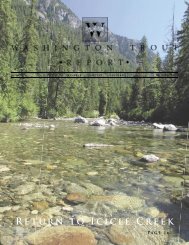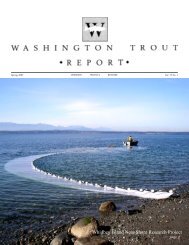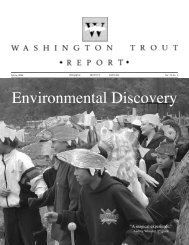Seafood Watch
Pacific Salmon - Wild Fish Conservancy
Pacific Salmon - Wild Fish Conservancy
- No tags were found...
Create successful ePaper yourself
Turn your PDF publications into a flip-book with our unique Google optimized e-Paper software.
<strong>Seafood</strong> <strong>Watch</strong>® Wild Pacific Salmon Report October 8, 2010<br />
2001). Generally, the timing of returns of ocean-type Chinook varies between late summer and<br />
the winter months, though in some river systems the fish may return for much of the year (PFMC<br />
2004a).<br />
The seasonal variation in salmon spawning is important as the same river system can support<br />
several runs of salmon. The 2004 PFMC Environmental Assessment notes that “not all runs<br />
types are equally abundant. In Oregon and Washington, spring (March through May) and fall<br />
(August through November) Chinook runs are most common; a few stocks run in summer (May<br />
through July). In California there are also late fall and winter runs (December through July) in<br />
the Sacramento River. A late fall run has also been reported from the Eel River” (PFMC 2004a).<br />
The fact that Pacific salmon are semelparous reduces the stability of population sizes. Because<br />
there is no overlap in the breeding population between years, one study (Waples 2002)<br />
demonstrated both theoretically and empirically that variable semelparous populations with<br />
overlapping year classes can reduce the effective population size in Pacific salmon. With respect<br />
to Chinook in particular, the author estimated a reduction of 40-60% in the effective population<br />
size of one particular Snake River Chinook salmon population due to variability in run sizes<br />
between years (Waples 2002).<br />
Habitat<br />
Human settlement along stream and river corridors during the past 150 years has<br />
altered the fundamental processes that created the habitat conditions under which<br />
salmonid populations have evolved and adapted over centuries. (Larsen et al.<br />
2004b)<br />
Over the past two centuries, habitat loss has become a major issue for Chinook and other<br />
salmonid species. Damming, logging, pollution, and hatchery fish have all put undue pressure on<br />
many wild Chinook stocks. As a consequence, the Pacific Fishery Management Council notes<br />
that “wild Chinook populations have disappeared from large areas where they used to flourish,<br />
and several evolutionarily significant units (ESUs) have been listed or proposed for listing as at<br />
risk for extinction under the Endangered Species Act” (PFMC 2004b). This is particularly true in<br />
the southern half of the Chinook salmon range, as graphically depicted in Figure 1.1.<br />
19






